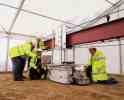 | Caithness.Org | Community | Business | Entertainment | Caithness... | Tourist Info | Site Map |
• Advertising • Chat Room • Contact Us • Kids Links • Links • Messageboard • News - Local & Scottish • News - UK & News Links • About / Contact Us • Submissions |
• Bookshop • Business Index & News • Jobs • Property For Sale • Property For Rent • Shop • Sutherland Business Index |
• Fishing • Fun Stuff • George, The Saga • Horses • Local Galas • Music • Pub Guide • Sport Index • What's On In Caithness |
• General Information • B & Bs • Backpackers • Caravan & Camping • Ferries • Getting Here • Holiday Letting • Hotels • Orkney • Pentland Firth • Sutherland • Taxis |
| N E W S F E E D S >>> |
|
Caithness.org News Bulletins |
||
| Dounreay News Index | Caithness.org News Index | |
|
NEW PARTICLE DETECTION
TECHNOLOGY TRIAL STARTS Alternative technologies offered by six different companies from the UK and USA are being tested for their sensitivity towards buried point sources on a simulated beach environment over a period of seven weeks in September and October 2005.
The trials follow a commitment by UKAEA to investigate a range of different technologies to see if practicable improvements can be made to the scanning of local beaches. The trials will provide UKAEA with the latest information and feedback on the systems available. The project is funded by UKAEA and is headed by Pete Burgess of Harwell, and Joe Toole and Stephen Innes from Dounreay. It will see a competition of different detectors with varying data processing techniques operating blind to find buried radioactive sources over a sand pit measuring 10 m by 6 m by 40cm deep. Non-UKAEA members of Dounreay’s beach monitoring steering group are providing an independent witness to observe the trials. Performance will be compared to the current system in use, which is RWE NUKEM’s Groundhog Evolution. Once the trials are completed, results will be assessed by the steering group at their next meeting in November. The trials will enable the six systems to be ranked in order of sensitivity. Other factors such as robustness, cost and area coverage rate will need to be taken into consideration. These particle detection trials at Harwell follow on from recent investigations into the offshore particle plume by a new remote operated vehicle (ROV) off Dounreay this year. UKAEA is testing an ROV that it intends to use to detect particles on the seabed, phasing out the use of divers.
|
||









